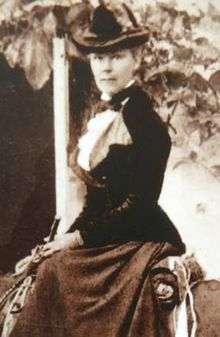Adela Breton
Adela Catherine Breton (31 December 1849 – June 1923) was an English archaeological artist and explorer. She made watercolour copies of the wall paintings of Mexican temples, notably those of the Upper Temple of Jaguars at Chichen Itza.
Adela Catherine Breton | |
|---|---|
 | |
| Born | 1849 London, United Kingdom |
| Died | 1923 (aged 73–74) Barbados |
| Nationality | British |
| Known for | Painting, Archeology |
Biography
Breton was born in London on 31 December 1849, to parents who were widely travelled. Her English father served in the Royal Navy and met Adela's mother (who was born in Somerset, England) while in Tasmania.[1] They moved to Bath, Somerset, a few months after Adela's birth and she grew up there.[1] During her childhood the family spent time travelling through Europe, visiting France, Switzerland and Italy. Adela probably studied art while staying in Florence.[2] With much of her time spent in Bath, with its Roman remains, the Bretons took a keen interest in the archaeology.[2] She stayed in Bath to look after her parents in their old age but, after her father died in 1887, she decided to travel. She made a conscious decision not to marry, so she could remain independent and satisfy her wanderlust.[3] She initially headed for Canada (and the United States) where she painted the landscape, before returning to Bath to hold an exhibition of her paintings.[4] In 1892 she made her first visit to Mexico. She hired a local guide, Pablo Solario.[4]
Her time in Mexico was spent travelling on horseback across the country, using her artistic skills to record the friezes, carvings and other archaeological treasures that were being unearthed in the Yucatán.[3] Her first trip lasted 18 months, when she travelled continually making notes and sketches.[5] As the 1890s passed, Breton spent less time on return visits to England and more time on her travels in Mexico. Her observations became more scientific and broadened to include the geology, the canyons and volcanoes.[6] However, she is particularly known for her colour paintings of the frescos discovered at Teotihuacan in 1894, at a site that became known as Teopancaxco.[7]
Breton's travels in Mexico were eventually curtailed by the Mexican revolution in 1910.[8] She was recognised internationally in her lifetime for her valuable contribution to Mesoamerican archaeology.[3]
Legacy

A collection of her work is held in Bristol Museum & Art Gallery, where a digitisation project was started in 2014 so that the fragile rolls of paintings can be preserved and made available for research.[9]
Some of her correspondence with Ella Lewis of Philadelphia is held in Harvard University Library.[10]
In 2016 a four-month exhibition entitled "The Remarkable Miss Breton" was held at the Bath Royal Literary & Scientific Institution in Bath.[3] In 2017 an exhibition of her original work was held at the Bristol Museum & Art Gallery.
References
- McVicker, Chapter 1, pp 1–4
- McVicker, Chapter 2, pp 7–11
- McFarlan, Tim (28 April 2016). "Victorian woman who left Bath behind to document Maya ruins in Mexico is celebrated in exhibition". Bath Chronicle. Retrieved 1 May 2017.
- McVicker, Chapter 3, pp 13–17
- McVicker, Chapter 4, pp 19–20
- McVicker, Chapter 6, pp 29–32
- McVicker, Chapter 7, pp 33–36
- McVicker, Adela Breton: A Victorian Artist Amid Mexico's Ruins, back page
- Giles, Sue; Harland, Valerie (13 November 2014). "Digitisation of the Adela Breton collection at Bristol Museum & Art Gallery". Public Catalogue Foundation. Retrieved 18 January 2017.
- "Breton, Adela, (1849-1923), Correspondence, 1915-1923, bulk: A Finding Aid". Harvard University Library. Archived from the original on 2014-10-02. Retrieved 18 November 2014.
Sources
- McVicker, Mary French (2005). Adela Breton: A Victorian Artist Amid Mexico's Ruins. University of New Mexico Press. ISBN 978-0-8263-3678-1.
Further reading
- Baigent, Elizabeth (2004). "Breton, Adela Catherine (1849–1923)". Oxford Dictionary of National Biography. Oxford University Press.
- Devlin, Kate (16 May 2013). "Adela Catherine Breton (1849-1923): A Career in Ruins" (blog). TrowelBlazers. Retrieved 18 November 2014.
- Ringle, William M. (2009). "The art of war: imagery of the upper temple of the Jaguars, Chichen Itza". Ancient Mesoamerica (01): 14–44.
- Sparrow-Niang, Jane (2017). "The Remarkable Miss Breton: artist, archaeologist, traveller". Bath Royal Literary and Scientific Institution.